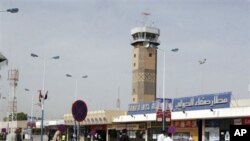The U.S.-bound parcel bombs that were recently intercepted in Europe and the Middle East were sent from Yemen. The working assumption of intelligence agencies is that the devices were manufactured and dispatched by al-Qaida in the Arabian Peninsula, an offshoot or franchise of the original al-Qaida.
The ties between Osama bin Laden's original al-Qaida, now believed hiding in Pakistan's tribal areas, and the Yemen-based Al-Qaida in Arabian Peninsula, or AQAP, are assumed to be strong. AQAP's leader, Nasser al Wahayshi, was once an aide to bin Laden in Afghanistan, and the Saudi-born bin Laden has spoken of his family's roots in Yemen. One of the original al-Qaida's early headline-creating successes was the suicide attack in 2000 on the U.S. Navy destroyer Cole while it was docked in the Yemeni port of Aden, which killed 17 American sailors.
But most analysts believe that AQAP conceives and carries out attacks on its own. Former Deputy National Intelligence Officer for Transnational Threats Glenn Carle says Osama bin Laden inspires, but does not order, his brethren in Yemen.
"Are they centrally controlled by Osama bin Laden, wherever he is? I think the answer is, no. Are they inspired by him? Clearly the answer is, yes. Do they receive general operational guidance? Probably in some ways they do. That's long been the case, but it generally amounts to, 'yes, brother, go with Allah and do this good job and you have my blessing.' There might be some [logistical] support, generally not too much," Carle states.
Like some other al-Qaida branches or offshoots, AQAP originated in the ranks of mujahedin veterans of the anti-Soviet war in Afghanistan in the 1980s. They operated out of both Saudi Arabia and Yemen. But beginning in 2003 Saudi authorities cracked down on al-Qaida, and many of the Saudi al-Qaida fled across the southern border to Yemen, where civil unrest and large areas of ungoverned territory gave them a hospitable haven.
In January 2009, the Saudi and Yemeni branches officially merged, under the name Al-Qaida in the Arabian Peninsula. The Yemeni government started its own crackdown on the jihadist movement, in part because of U.S. urging, culminating in an open declaration of war on AQAP in July.
Former U.S. Homeland Security Intelligence Chief Charles Allen, a 47-year-veteran of the CIA, says AQAP is gathering strength.
"Al-Qaida in the Arabian Peninsula is now starting to really flourish," Allens said. "It's been regaining strength over the last two years. When I was undersecretary [for intelligence] at Homeland Security we were concerned about a resurgence of Al-Qaida in Yemen, particularly because we saw Anwar al-Alawki really appealing to North Americans and to West Europeans through his messaging and preaching violent attacks against the West and against the United States."
Al-Alawki is an Yemeni-American, born in the U.S. state of New Mexico and educated at American universities. He is considered by counterterrorism officials to be a senior recruiter and spiritual motivator for AQAP, especially to English-speaking jihadists. He started an English-language jihadist magazine called Inspire, the first issue of which carried an article entitled Make a Bomb in the Kitchen of Your Mom.
Alleged Fort Hood shooter Major Nidal Hassan was in email contact with al-Alawki before the army officer opened fire at the base on Nov. 5 of last year, killing 13 people and wounding 30 others. Intelligence officials have said al-Alawki also recruited and trained Umar Farouk Abdulmuttalab, who attempted to blow up an airliner over Detroit on December 25, 2009. Although he has not been apprehended, Al-Awlaki is now on trial in absentia in Yemen on terrorism charges.
Philip Mudd, former deputy director of the FBI's National Security Branch, says the latest parcel bomb plot shows that AQAP is resilient and resourceful, able to change tactics as Western societies adapt to terrorist threats.
"The range of vulnerabilities in an open society is remarkable. So I think there is ingenuity," Mudd said. "But if you sat down with a cup of coffee and said, look at all these options we have, let's spend a month or two finding a couple that nobody has thought of, it doesn't take a rocket scientist in an open society to come up with ways that that society might be vulnerable."
AQAP also has at least one highly skilled bombmaker in its ranks, identified as Ibrahim al-Asiri. Counterterrorism officials are focused on him as the most likely designer and maker of the parcel bombs hidden in computer printer toner cartridges, as well as the underwear bomb carried by Abdulmutallab last December 25.
Al-Qaida in Arabian Peninsula Comes Into Its Own











